Numerical Investigations of Snowdrift Characteristics on Roofs with Consideration of Snow Crystal Morphological Features
Abstract
1. Introduction
2. Numerical Model Incorporating Snow Morphology Effects
2.1. Drag Coefficient of Typical Snow Crystals
2.2. Numerical Model Considering Snow Crystal Morphologies
3. Validation of Numerical Model
3.1. Test Prototype
3.2. Comparative Analysis
4. Snowdrifts on Flat Roofs Under Effects of Snow Morphologies
4.1. Analysis Settings of Simulations for Flat Roofs
4.2. Snowdrift Characteristics on Flat Roofs
5. Snowdrifts on Single-Pitched Roofs Under Effects of Snow Morphologies
5.1. Analysis Settings of Simulations for Single-Pitched Roofs
5.2. Snowdrift Characteristics on Single-Pitched Roofs
6. Conclusions
- Based on the multiphase model in ANSYS software, this study develops a method that accounts for the aerodynamic drag variations in snow particles with different geometric morphologies. By integrating a shape-dependent drag function into the momentum equations, the model could characterize the differential momentum exchange between air flow and non-spherical snow particles. Comprehensive validation against experimental data confirms that the refined model could reasonably predict both particle trajectories and resulting accumulation patterns under coupled wind–snow conditions. This model overcomes the limitations of the traditional spherical particle assumption, offering an alternative approach for simulating the motion of snow particles with various morphological features on a building-scale roof.
- The differences in the motion characteristics of snow particles with various shapes essentially stem from variations in their drag coefficients. The drag coefficient directly influences the falling velocities of snow particles, which in turn leads to significant disparities in snow concentration distribution, snow deposition amount, and snow accumulation patterns. Specifically, a higher drag coefficient results in a slower falling velocity of snow particles, ultimately leading to a reduction in snow deposition on roofs.
- For flat roofs, the relatively low wind speed near the surface leads to limited erosive effects of airflow. Consequently, snow distribution is predominantly controlled by the snow deposition process, which becomes the dominant factor governing snow accumulation on flat roofs. However, as the roof span increases, the influence of snow particle morphology on accumulation patterns gradually decreases. In contrast, the inclined surface of pitched roofs enhances wind-induced snow erosion, further diminishing the role of particle shape in snow deposition. Nevertheless, regardless of roof type, the drag coefficient of snow particles controls the macroscopic pattern of snow distribution by governing the falling velocity and deposition efficiency.
Author Contributions
Funding
Data Availability Statement
Acknowledgments
Conflicts of Interest
Abbreviations
| CFD | Computational Fluid Dynamics |
| CES | Cryospheric Environment Simulator |
References
- Magono, C. Meteorological classification of snow crystals. J. Jpn. Soc. Snow Ice 1962, 24, 33–37. [Google Scholar] [CrossRef]
- Kikuchi, K.; Kameda, T.; Higuchi, K. A global classification of snow crystals, ice crystals, and solid precipitation based on observations from middle latitudes to polar regions. Atmos. Res. 2013, 132, 460–472. [Google Scholar] [CrossRef]
- Muramoto, K.; Matsuura, K.; Shiina, T. Measuring the density of snow particles and snowfall rate. Electr. Commun. Jpn. 1995, 78, 2353–2360. [Google Scholar] [CrossRef]
- Yagi, T. Measurement of the fall velocity of ice crystals drifting in supercooled fog. J. Meteorol. Soc. Jpn. 1970, 48, 287–292. [Google Scholar] [CrossRef]
- Locatelli, J.; Hobbs, P.V. Fall speeds and masses of solid precipitation particles. J. Geophys. Res. 1974, 79, 2185–2197. [Google Scholar] [CrossRef]
- Heymsfield, A. Ice crystal terminal velocities. J. Atmos. Sci. 1972, 29, 1348–1357. [Google Scholar] [CrossRef]
- Finny, E.A. Snowdrift Control by Highway Design: No. 86; Michigan Engineering Experiment Station: East Lansing, MI, USA, 1939. [Google Scholar]
- Gerdel, R.W.; Strom, G.H. Wind Tunnel Studies with Scale Model Simulated Snow; International Association of Scientific Hydrology: Wallingford, UK, 1961. [Google Scholar]
- Kind, R.J. A critical examination of the requirements for model simulation of wind-induced erosion/deposition phenomena such as snow drifting. Atmos. Environ. 1976, 10, 219–227. [Google Scholar] [CrossRef]
- Kind, R.J.; Murray, S.B. Saltation flow measurements relating to modeling of snowdrifting. J. Wind Eng. Ind. Aerodyn. 1982, 10, 89–102. [Google Scholar] [CrossRef]
- Iversen, J.D. Drifting snow similitude—Drift rate correlation. In Proceedings of the International Conference on Wind Engineering, Fort Collins, CO, USA, 8–14 July 1979. [Google Scholar]
- Iversen, J.D. Aeolian processes in the environmental wind tunnel and in the atmosphere. In Physics of Desertification; Springer: Berlin/Heidelberg, Germany, 1986; pp. 318–321. [Google Scholar]
- Delpech, P.; Palier, P.; Gandemer, J. Snowdrifting simulation around Antarctic buildings. J. Wind Eng. Ind. Aerodyn. 1998, 74–76, 567–576. [Google Scholar] [CrossRef]
- Okaze, T.; Tominaga, Y.; Mochida, A. Numerical modelling of drifting snow around buildings. In Proceedings of the 6th International Symposium on Turbulence, Heat and Mass Transfer, Rome, Italy, 14–18 September 2009. [Google Scholar]
- Fan, F.; Li, R.; Zhang, Q.; Zhang, G.; Mo, H. A complete environmental wind tunnel for studying the evolution of snow accumulations under the effects of wind, rain, and heat. J. Wind Eng. Ind. Aerodyn. 2024, 252, 105817. [Google Scholar] [CrossRef]
- Zhang, G.; Zhang, Q.; Mo, H.; Guo, D.; Zhi, X.; Wu, J.; Fan, F. CFD investigations into snow loads on tandem-arranged gabled-roofed buildings under mutual interferences. Cold Reg. Sci. Technol. 2025, 238, 104547. [Google Scholar] [CrossRef]
- Zhang, Q.; Zhang, G.; Zheng, R.; Mo, H.; Zhi, X.; Wu, J.; Fan, F. Research on controlling measures of snowdrifts around Arctic ground-based buildings through shape optimization. Cold Reg. Sci. Technol. 2025, 231, 104382. [Google Scholar] [CrossRef]
- Lee, B.; Tu, J.; Fletcher, C. On numerical modeling of particle-wall impaction in relation to erosion prediction: Eulerian versus lagrangian method. Wear 2002, 252, 179–188. [Google Scholar] [CrossRef]
- Wang, Z.S.; Huang, N. Numerical simulation of the falling snow deposition over complex terrain. J. Geophys. Res. Atmos. 2017, 122, 980–1000. [Google Scholar] [CrossRef]
- Huang, N.; Wang, Z.S. The formation of snow streamers in the turbulent atmosphere boundary Layer. Aeolian Res. 2016, 23, 1–10. [Google Scholar] [CrossRef]
- Uematsu, T.; Kaneda, Y.; Takeuchi, K.; Nakata, T.; Yukumi, M. Numerical simulation of snowdrift development. Ann. Glaciol. 1989, 13, 265–268. [Google Scholar] [CrossRef]
- Liston, G.E.; Brown, R.L.; Dent, J.D. A two-dimensional computational model of turbulent atmospheric surface flows with drifting snow. Ann. Glaciol. 1993, 18, 281–286. [Google Scholar] [CrossRef]
- Naaim, M.; Naaim-Bouvet, F.; Martinez, H. Numerical simulation of drifting snow: Erosion and deposition models. Ann. Glaciol. 1998, 26, 191–196. [Google Scholar] [CrossRef]
- Tominaga, Y.; Mochida, A. CFD prediction of flowfield and snowdrift around a building complex in a snowy region. J. Wind Eng. Ind. Aerodyn. 1999, 81, 273–282. [Google Scholar] [CrossRef]
- Pomeroy, J.W.; Male, D.H. Steady-state suspension of snow. J. Hydrol. 1992, 136, 275–301. [Google Scholar] [CrossRef]
- Okaze, T.; Takano, Y.; Mochida, A.; Tominaga, Y. Development of a new k-ε model to reproduce the aerodynamic effects of snow particles on a flow field. J. Wind Eng. Ind. Aerodyn. 2015, 144, 118–124. [Google Scholar] [CrossRef]
- Zhou, X.; Zhang, Y.; Kang, L.; Gu, M. CFD simulation of snow redistribution on gable roofs: Impact of roof slope. J. Wind Eng. Ind. Aerodyn. 2019, 185, 16–32. [Google Scholar] [CrossRef]
- Zhou, X.; Zhang, Y.; Gu, M. Coupling a snowmelt model with a snowdrift model for the study of snow distribution on roofs. J. Wind Eng. Ind. Aerodyn. 2018, 182, 235–251. [Google Scholar] [CrossRef]
- Beyers, J.H.M.; Sundsbo, P.A.; Harms, T.M. Numerical simulation of three-dimensional, transient snow drifting around a cube. J. Wind Eng. Ind. Aerodyn. 2004, 92, 725–747. [Google Scholar] [CrossRef]
- Zhang, G.L.; Zhang, Q.W.; Fan, F.; Shen, S.Z. Numerical Simulations of Development of Snowdrifts on Long-Span Spherical Roofs. Cold Reg. Sci. Technol. 2021, 182, 103211. [Google Scholar] [CrossRef]
- Zhang, G.L.; Zhang, Q.W.; Fan, F.; Shen, S.Z. Numerical Simulations of Snowdrift Characteristics on Multi-span Arch Roofs. J. Wind Eng. Ind. Aerodyn. 2021, 212, 104593. [Google Scholar] [CrossRef]
- Libbrecht, K. The enigmatic snowflake. Phys. World. 2008, 21, 19–23. [Google Scholar] [CrossRef]
- Nakaya, U.; Sekido, Y. General Classification of Snow Crystals and their Frequency of Occurrence. J. Fac. Sci. 1936, 1, 243–264. [Google Scholar]
- Hobbs, P.V.; Fletcher, N.H. Ice Physics. Phys. Today 1975, 28, 71–72. [Google Scholar] [CrossRef]
- Abraham, F.F. Functional dependence of drag coefficient of a sphere on Reynolds number. Phys. Fluids 1970, 13, 2194–2195. [Google Scholar] [CrossRef]
- Mccorquodale, M.W.; Westbrook, C.D. TRAIL part 2: A comprehensive assessment of ice particle fall speed parametrisations. Q. J. R. Meteorol. Soc. 2021, 147, 605–626. [Google Scholar] [CrossRef]
- Mccorquodale, M.W.; Westbrook, C.D. TRAIL: A novel approach for studying the aerodynamics of ice particles. Q. J. R. Meteorol. Soc. 2021, 147, 589–604. [Google Scholar] [CrossRef]
- Boutanios, Z.; Jasak, H. Two-way coupled Eulerian-Eulerian simulations of drifting snow with viscous treatment of the snow phase. J. Wind Eng. Ind. Aerodyn. 2017, 169, 67–76. [Google Scholar] [CrossRef]
- Thiis, T.K.; O’rourke, M. Model for snow loading on gable roofs. J. Struct. Eng.-ASCE 2015, 141, 04015051. [Google Scholar] [CrossRef]
- Mo, H.M.; Fan, F.; Hong, H.P. Evaluation of input wind speed used in wind tunnel test and numerical simulation to estimate drifting snow profile. J. Build. Struct. 2015, 36, 75–80+90. (In Chinese) [Google Scholar]
- Zhou, X.; Kang, L.; Gu, M.; Qiu, L.; Hu, J. Numerical simulation and wind tunnel test for redistribution of snow on a flat roof. J. Wind Eng. Ind. Aerodyn. 2016, 153, 92–105. [Google Scholar] [CrossRef]
- Zhu, F.; Yu, Z.X.; Zhao, L.; Xue, M.Q.; Zhao, S.C. Adaptive-mesh method using RBF interpolation: A time-marching analysis of steady snow drifting on stepped flat roofs. J. Wind Eng. Ind. Aerodyn. 2017, 171, 1–11. [Google Scholar] [CrossRef]
- Wang, J.S.; Liu, H.B.; Xu, D.; Chen, Z.H.; Ma, K.J. Modeling snowdrift on roofs using Immersed Boundary Method and wind tunnel test. Build. Environ. 2019, 160, 106208. [Google Scholar] [CrossRef]
- Zhang, G.L.; Zhang, Q.W.; Mo, H.M.; Li, R.; Liu, M.M.; Fan, F. Experimental Investigation of Snow Accumulations on Two-Span Single-Pitched Roofs Based on a New Similarity Criterion. Front. Earth Sci. 2022, 10, 785010. [Google Scholar] [CrossRef]
- GB50009-2012; Load Code for the Design of Building Structures. Ministry of Construction of the People’s Republic of China; China Building Industry Press: Beijing, China, 2012.
- Tominaga, Y.; Okaze, T.; Mochida, A. CFD modeling of snowdrift around a building: An overview of models and evaluation of a new approach. Build. Environ. 2011, 46, 899–910. [Google Scholar] [CrossRef]
- Tominaga, Y.; Stathopoulos, T. Numerical simulation of dispersion around an isolated cubic building: Comparison of various types of k-ε models. Atmos. Environ. 2009, 43, 3200–3210. [Google Scholar] [CrossRef]
- Tominaga, Y.; Okaze, T.; Mochida, A. CFD simulation of drift snow loads for an isolated gable-roof building. In Proceedings of the 8th International Conference on Snow Engineering, Nantes, France, 14–17 June 2016. [Google Scholar]
- NRCC. National Building Code of Canada; Institute for Research in Construction, National Research Council of Canada: Ottawa, ON, Canada, 2015. [Google Scholar]
- ISO 4355; Bases for Design of Structures—Determination of Snow Loads on Roofs. International Organization for Standardization: Geneva, Switzerland, 2013.
- ASCE/SEI 7-16; Minimum Design Loads for Buildings and Other Structures. American Society of Civil Engineering: Reston, VA, USA, 2016.
- Zhang, G.L.; Zhang, Y.; Yin, Z.A.; Zhang, Q.W.; Mo, H.M.; Wu, J.Z.; Fan, F. CFD Simulations of Snowdrifts on a Gable Roof: Impacts of Wind Velocity and Snowfall Intensity. Buildings 2022, 12, 1878. [Google Scholar] [CrossRef]
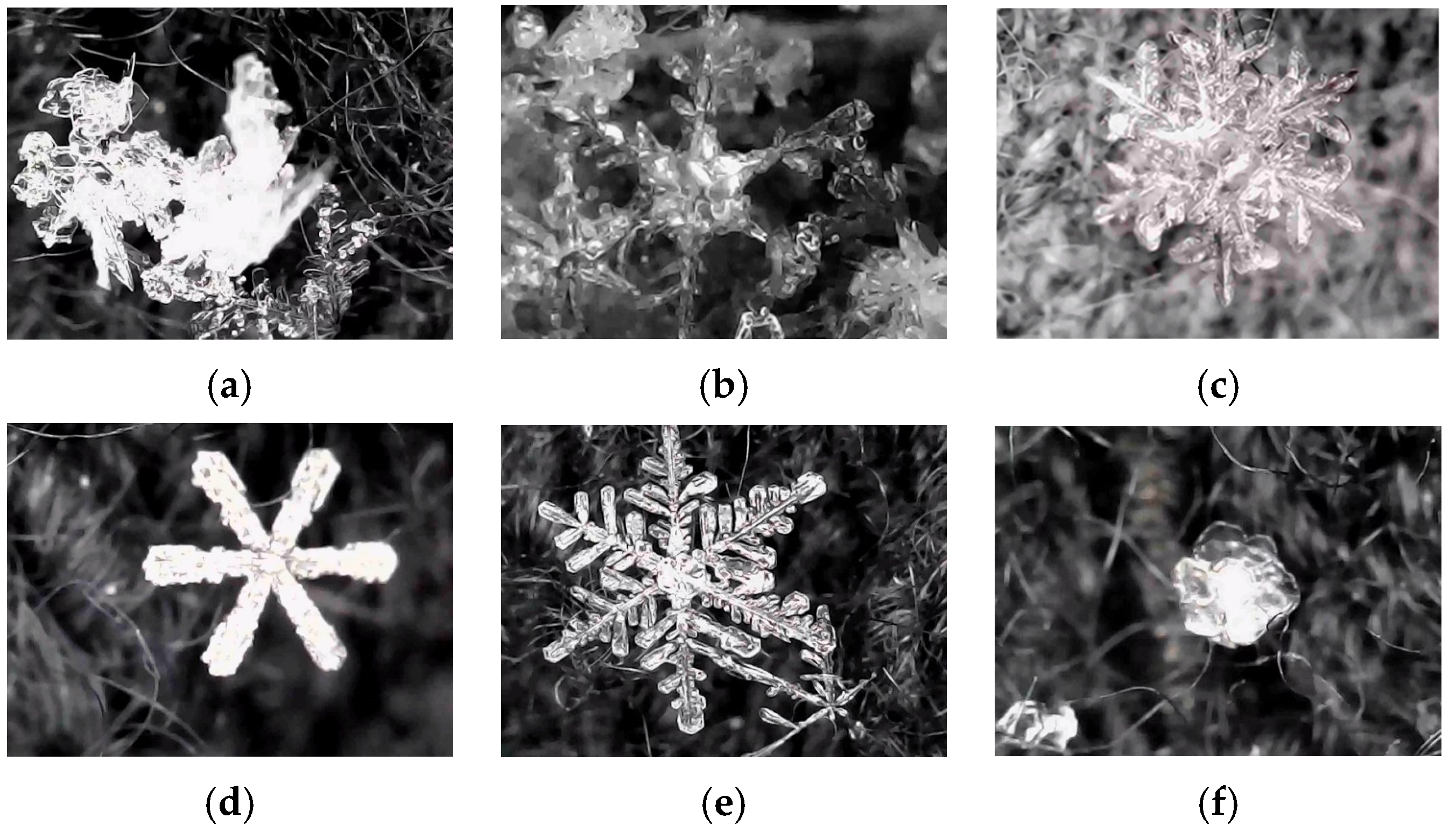
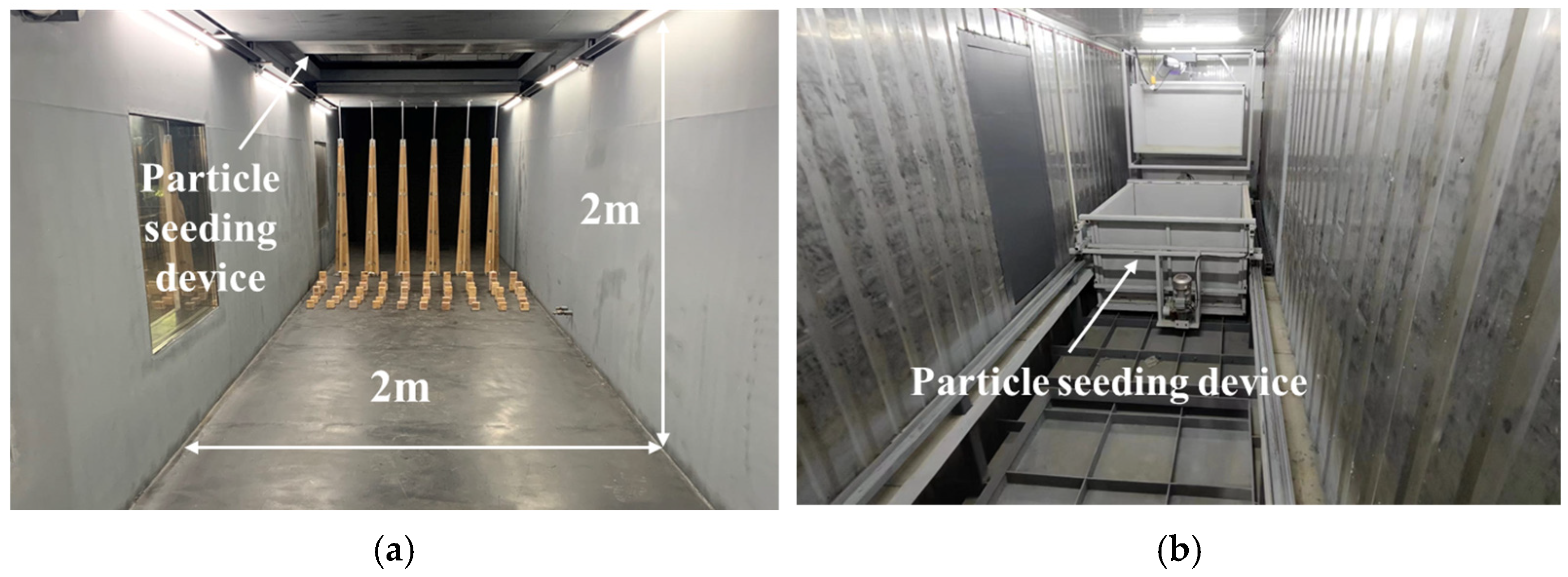

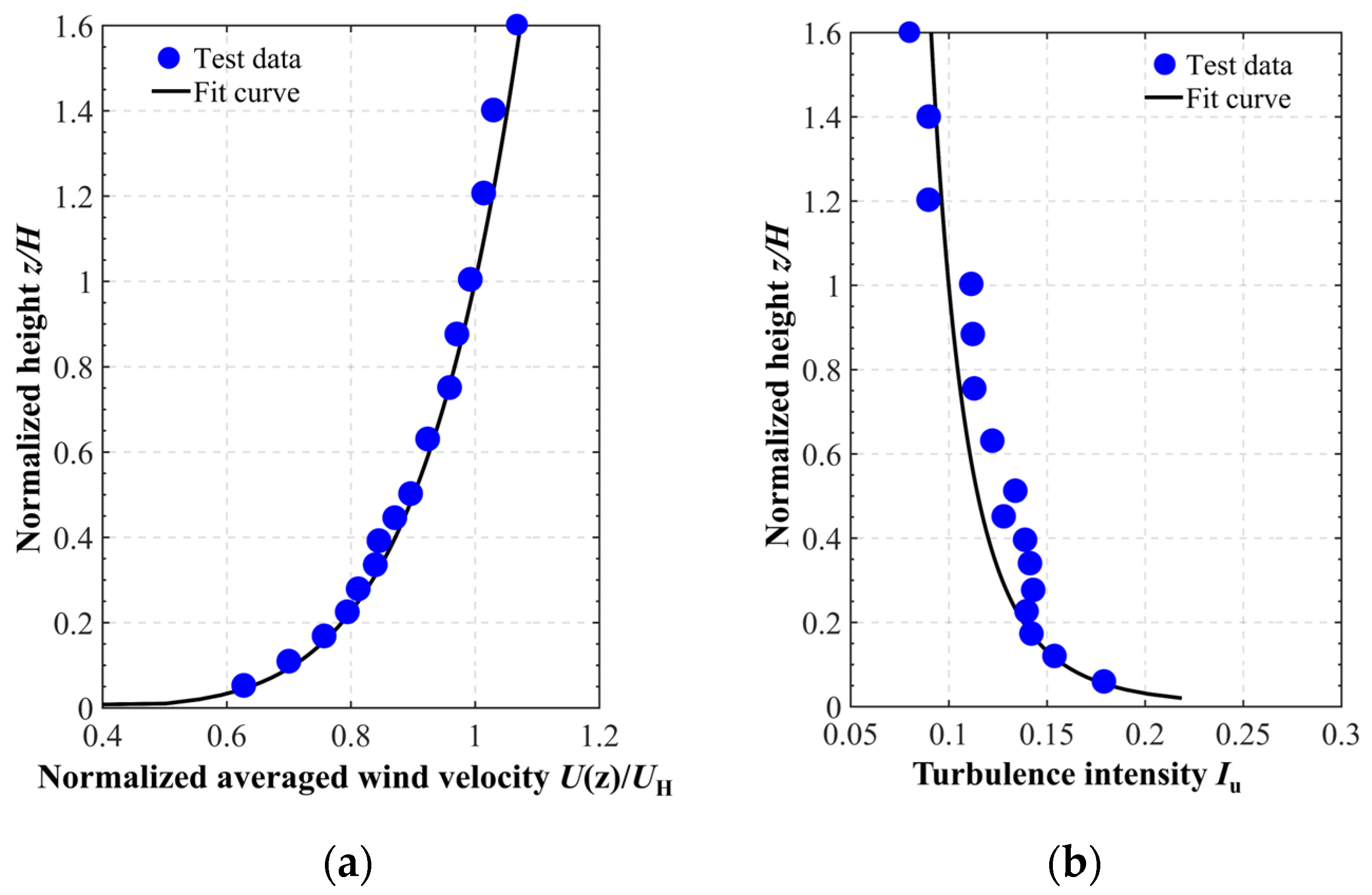
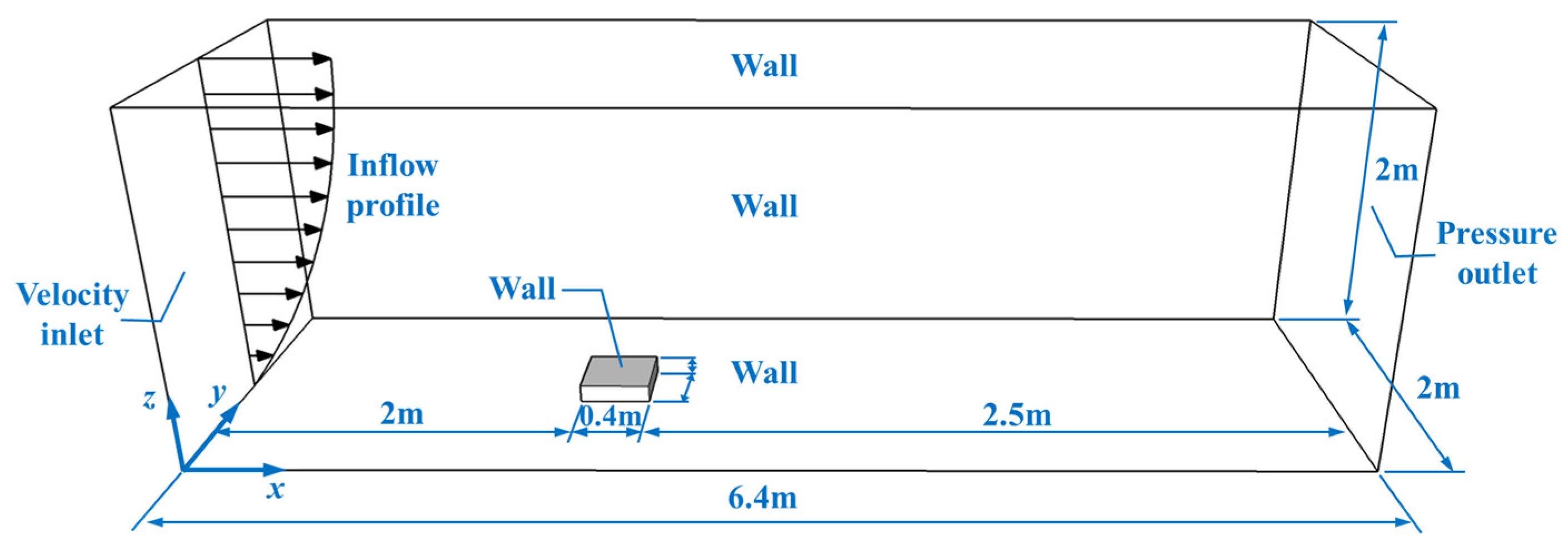

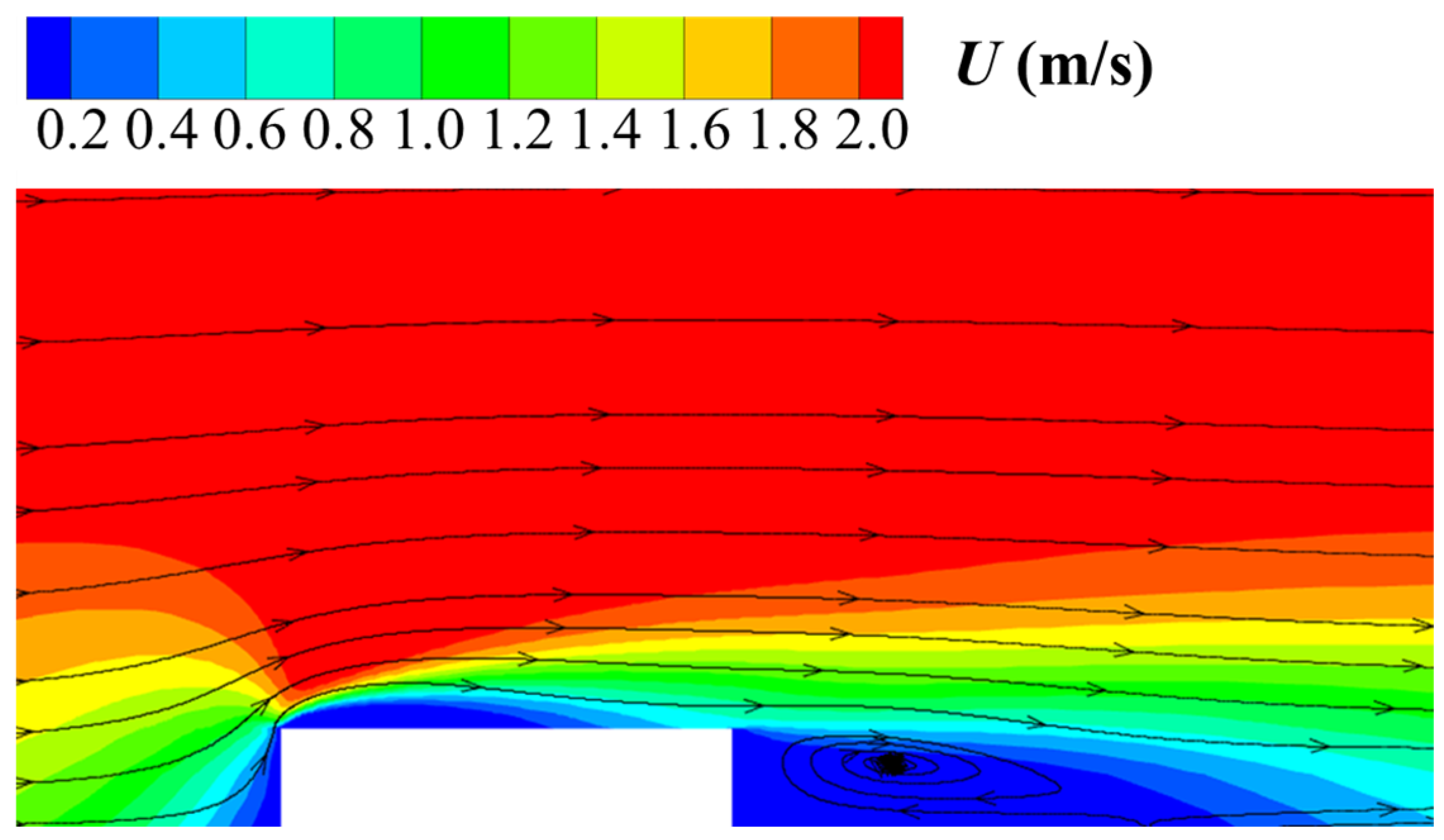
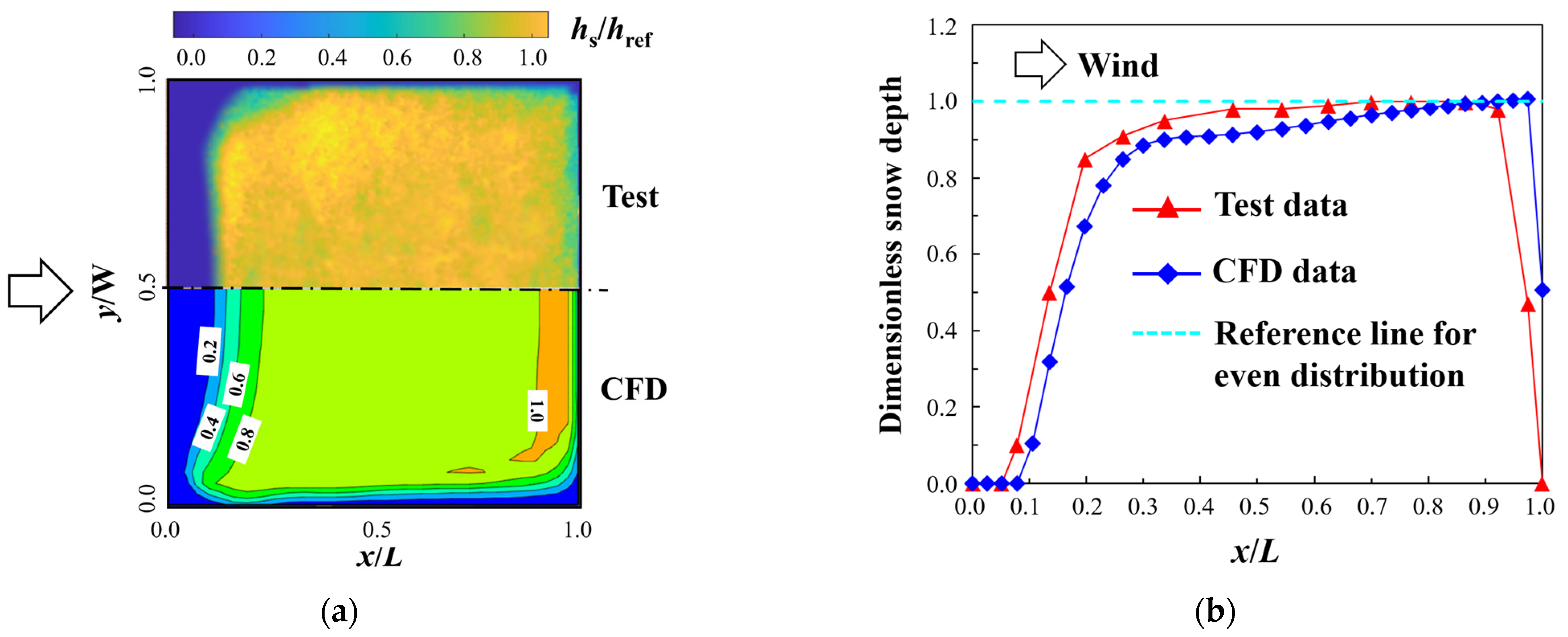
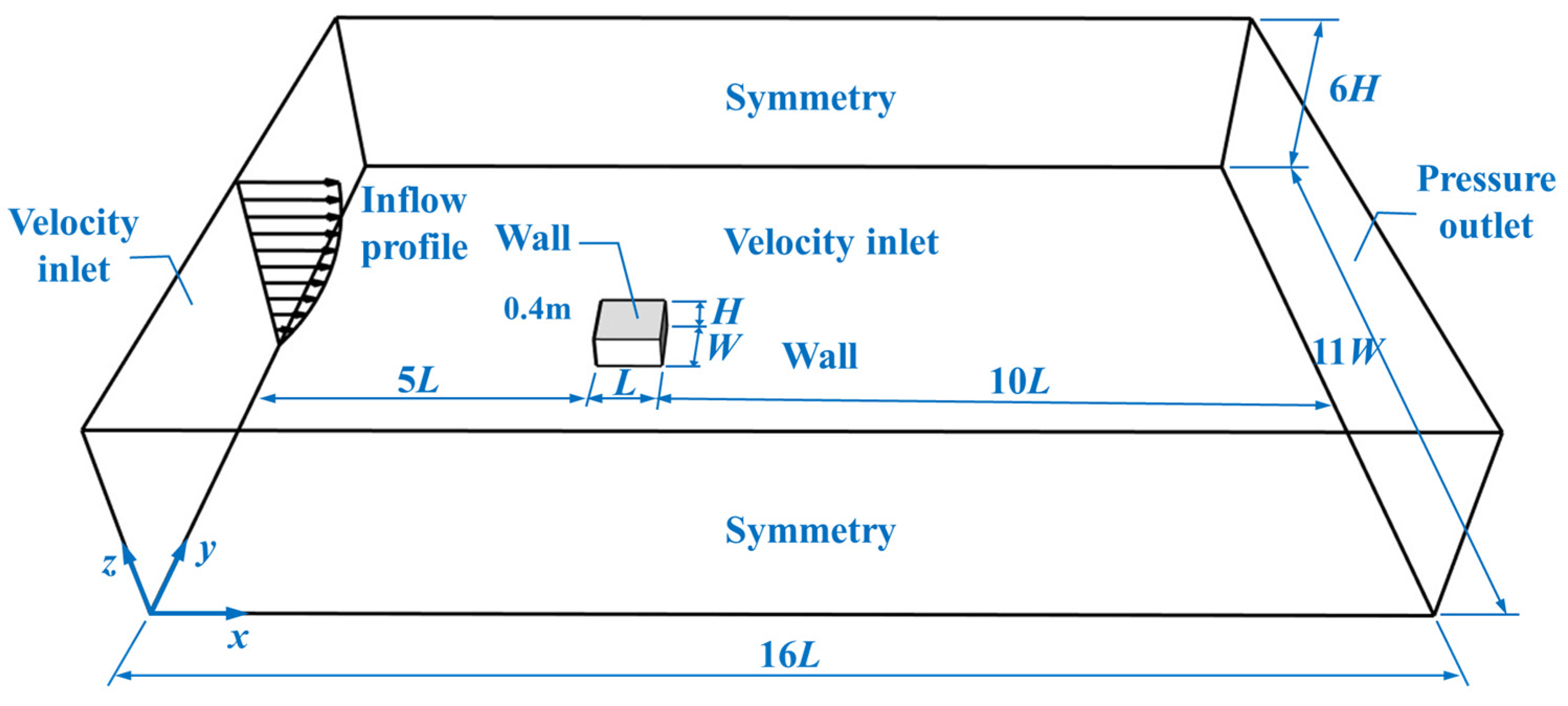
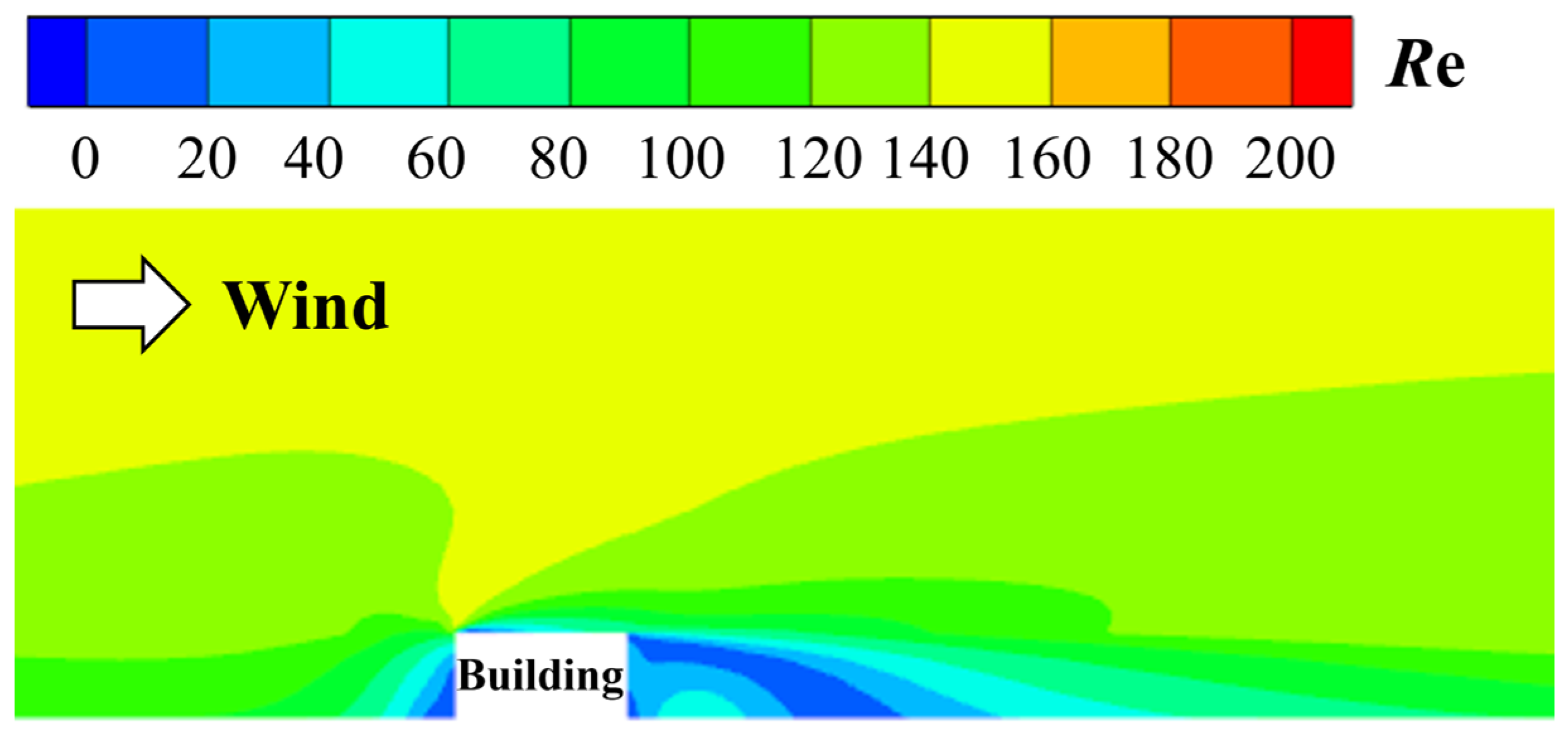
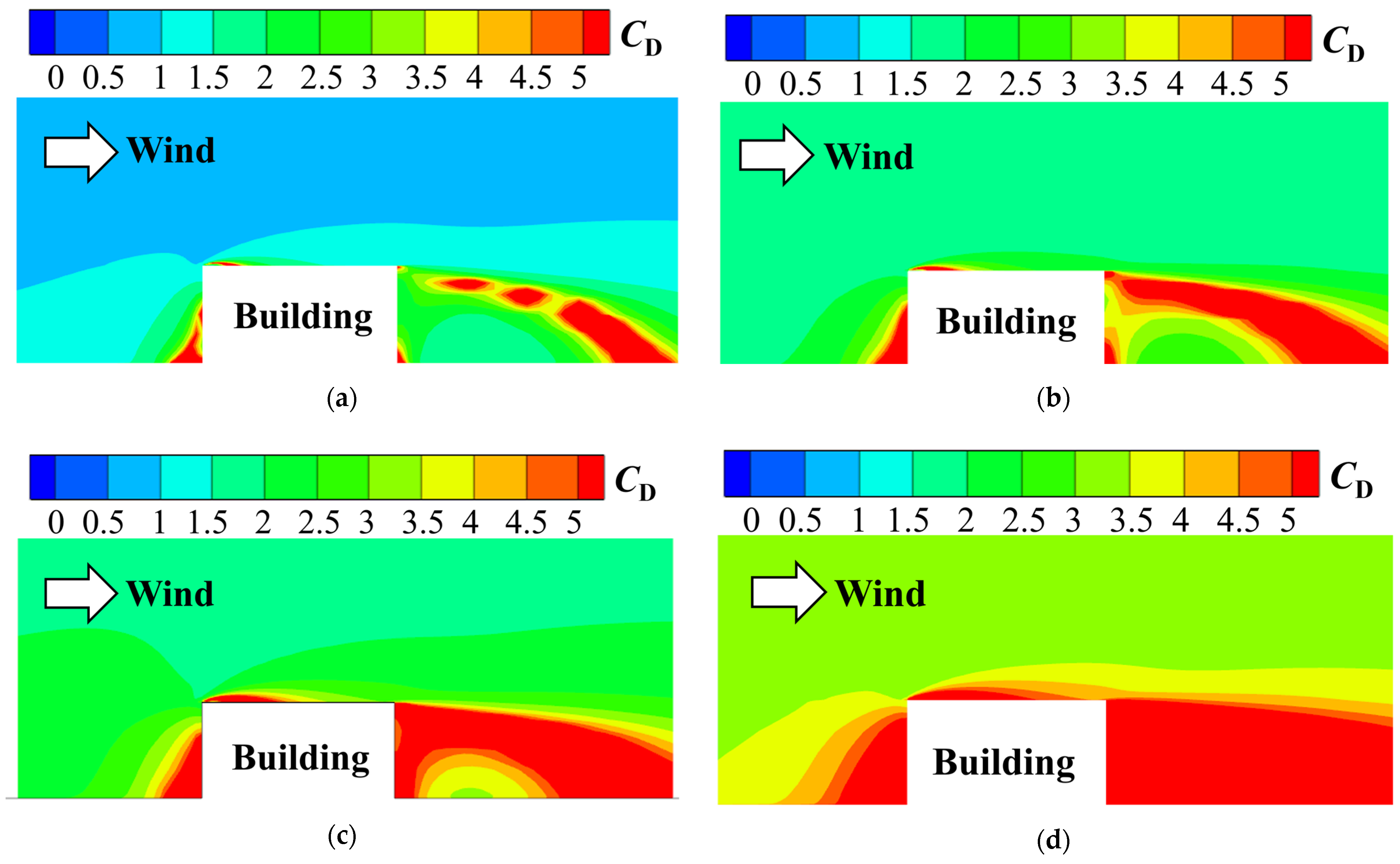
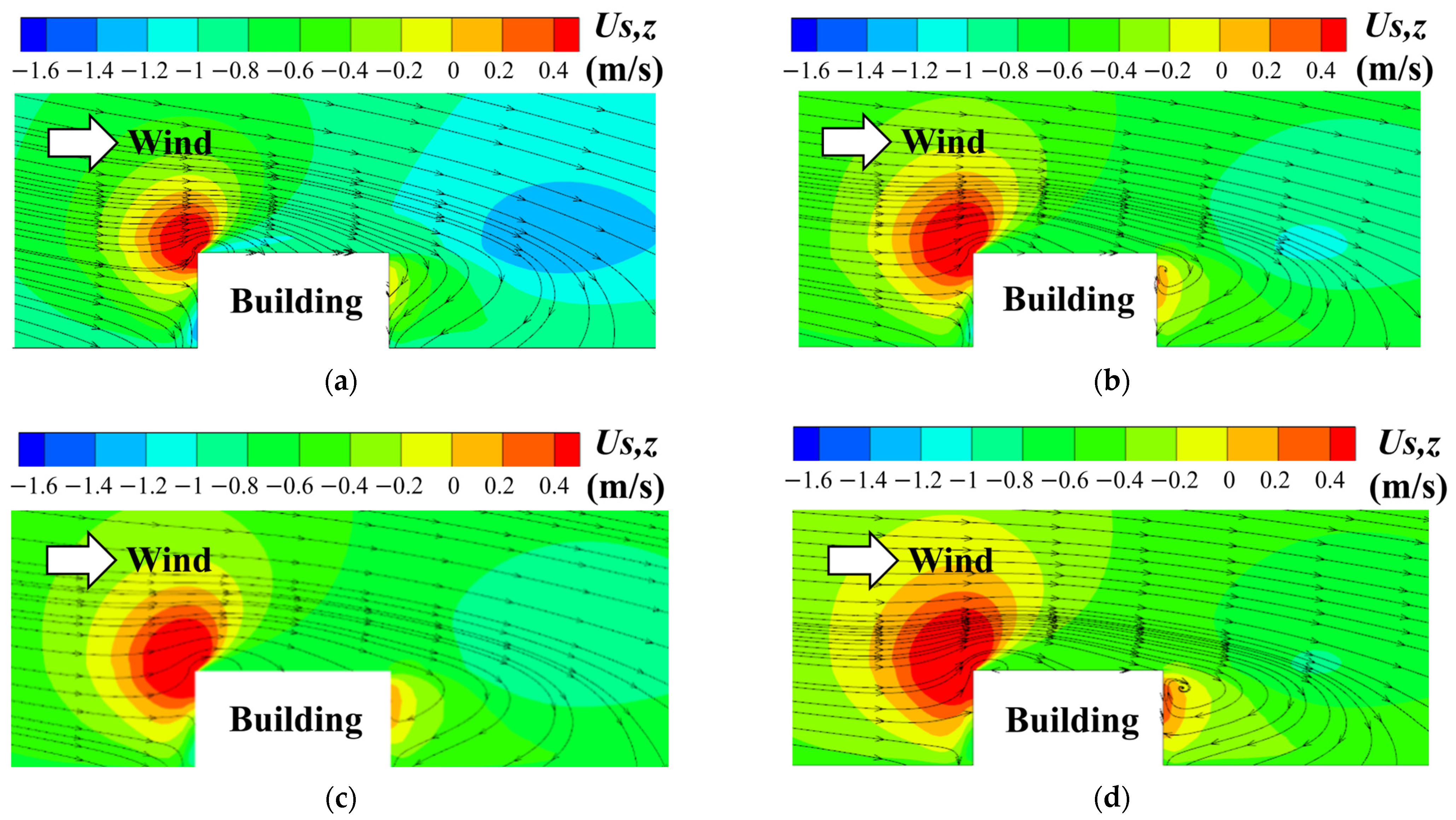
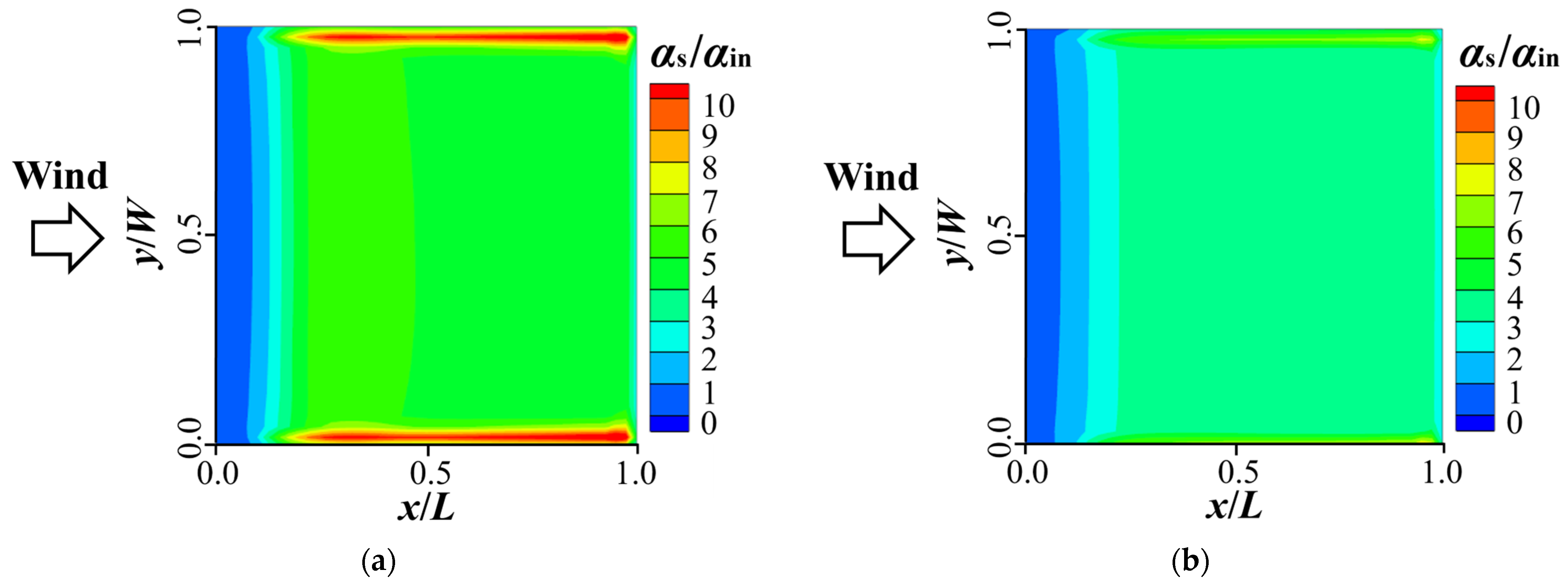
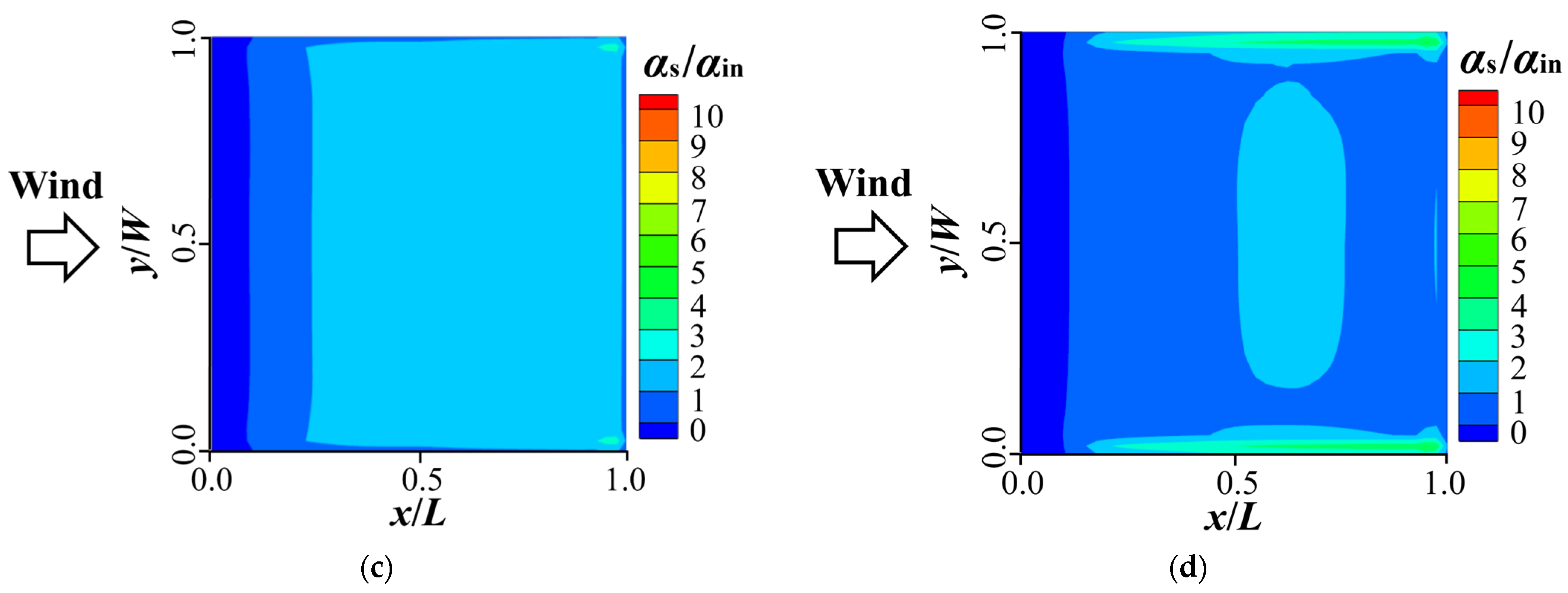


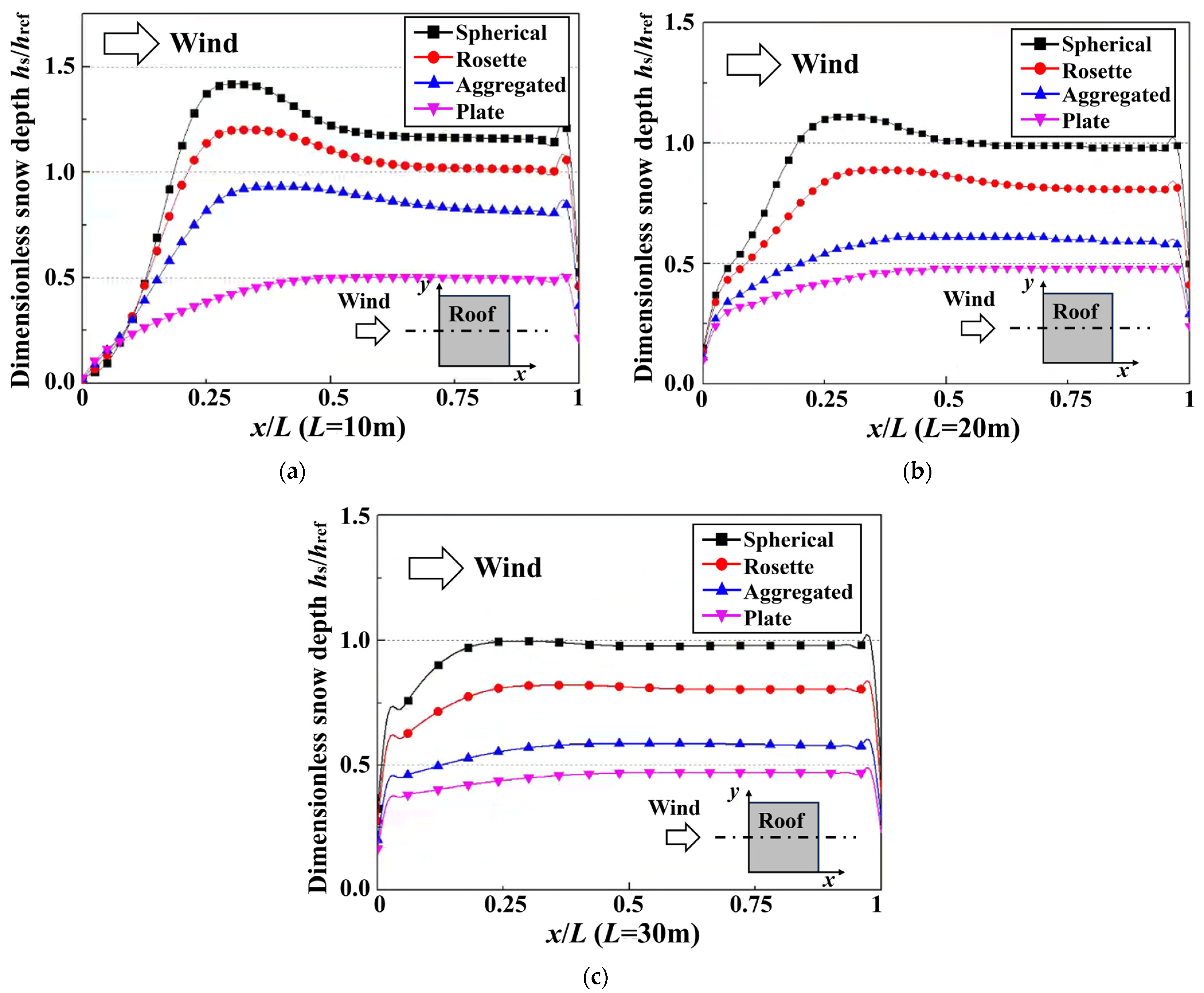
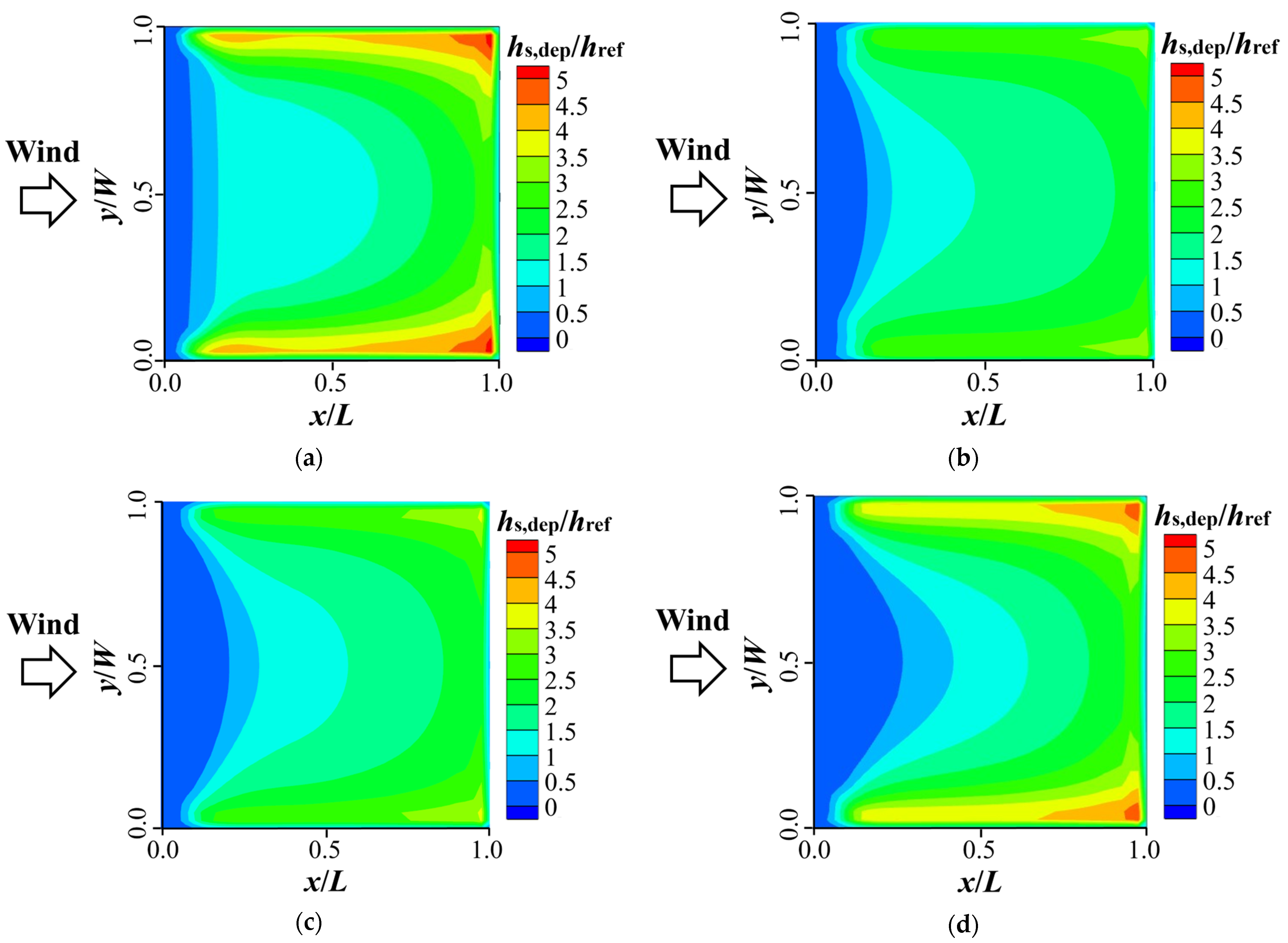

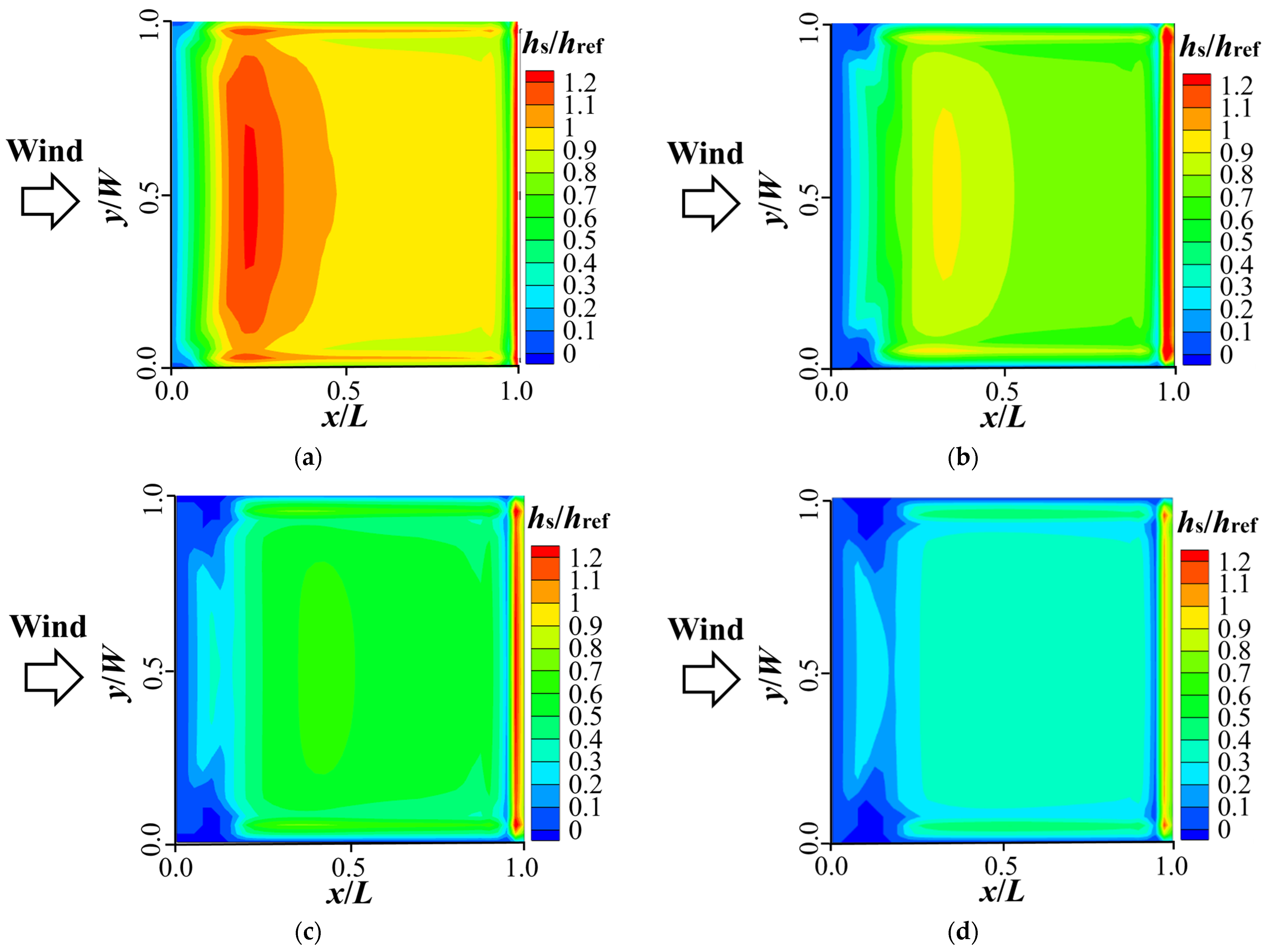
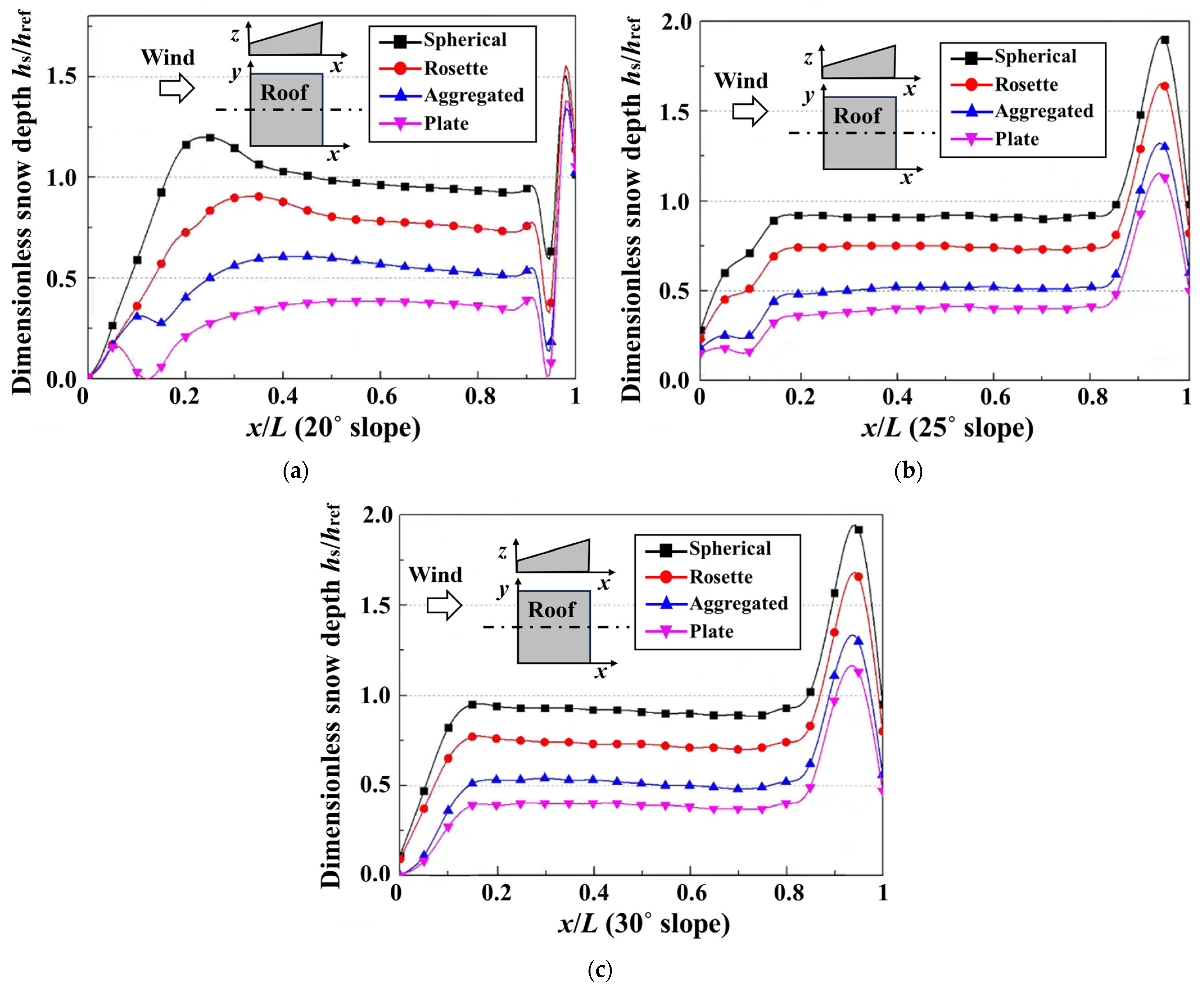
| Non-Spherical Snow Crystals | Drag Coefficient | No. |
|---|---|---|
| Plate | Re < 10,000 | (7) |
| Rosette | Re < 10,000 | (8) |
| Aggregate | Re < 10,000 | (9) |
| No. | Similarity Number | Prototype | Scaled Test |
|---|---|---|---|
| 1 | 0.002 | 0.002 | |
| 2 | 3.26 × 10−5 | 6.53 × 10−5 | |
| 3 | 0.17 | 0.20 | |
| 4 | 15.6 | 12.5 | |
| 5 | 1.11 | 1.04 |
Disclaimer/Publisher’s Note: The statements, opinions and data contained in all publications are solely those of the individual author(s) and contributor(s) and not of MDPI and/or the editor(s). MDPI and/or the editor(s) disclaim responsibility for any injury to people or property resulting from any ideas, methods, instructions or products referred to in the content. |
© 2025 by the authors. Licensee MDPI, Basel, Switzerland. This article is an open access article distributed under the terms and conditions of the Creative Commons Attribution (CC BY) license (https://creativecommons.org/licenses/by/4.0/).
Share and Cite
Zhang, G.; Zhang, Q.; Mo, H.; Zhao, Y.; Zhi, X.; Fan, F. Numerical Investigations of Snowdrift Characteristics on Roofs with Consideration of Snow Crystal Morphological Features. Buildings 2025, 15, 3606. https://doi.org/10.3390/buildings15193606
Zhang G, Zhang Q, Mo H, Zhao Y, Zhi X, Fan F. Numerical Investigations of Snowdrift Characteristics on Roofs with Consideration of Snow Crystal Morphological Features. Buildings. 2025; 15(19):3606. https://doi.org/10.3390/buildings15193606
Chicago/Turabian StyleZhang, Guolong, Qingwen Zhang, Huamei Mo, Yueyue Zhao, Xudong Zhi, and Feng Fan. 2025. "Numerical Investigations of Snowdrift Characteristics on Roofs with Consideration of Snow Crystal Morphological Features" Buildings 15, no. 19: 3606. https://doi.org/10.3390/buildings15193606
APA StyleZhang, G., Zhang, Q., Mo, H., Zhao, Y., Zhi, X., & Fan, F. (2025). Numerical Investigations of Snowdrift Characteristics on Roofs with Consideration of Snow Crystal Morphological Features. Buildings, 15(19), 3606. https://doi.org/10.3390/buildings15193606




